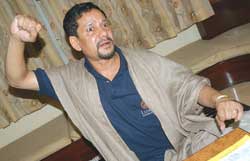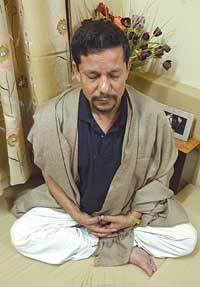"I can't stand heights," he says, but overcomes vertigo to show us from this vantage point some of his plans to make Nepal's capital more liveable. His hands slice through the crisp morning air to point out the Bishnumati corridor, the Dhobikhola diversion, plans to gentrify Asan, to relocate the bus-stop and turn Bagh Bazar into a high-rise commercial centre.
Keshab Sthapit is a man in a hurry and wants to be known as a mayor who gets things done. In a country where most politicians are talkers, Sthapit delivers. And he will literally bulldoze through the city to beautify intersections, broaden boulevards or create parks. And you better not be in his way. No wonder, during his first tenure as mayor, Sthapit earned himself the nickname 'Demolition Man'.
 As soon as he was nominated mayor by the Thapa government last month, Sthapit was back to where he had left off, pulling down the petrol pump at Bhotahity to make way for a park. "This is my city. Let's see who'll stop me," he says with characteristic bravado. And, except for those whose houses were directly in his bulldozers' path, most Kathmanduites are happy to at last see a public official who actually makes things happen.
As soon as he was nominated mayor by the Thapa government last month, Sthapit was back to where he had left off, pulling down the petrol pump at Bhotahity to make way for a park. "This is my city. Let's see who'll stop me," he says with characteristic bravado. And, except for those whose houses were directly in his bulldozers' path, most Kathmanduites are happy to at last see a public official who actually makes things happen. To be sure, most of Sthapit's plans are grandiose, like his project to raze Bagh Bazar and build highrise office blocks, buy Asan's bahals to renovate them and turn the area into an IT centre, make a 50km garden along the Ring Road or build a megamall on Tinkune. Critics call him a megalomaniac.
"I don't just demolish things," says the mayor, "besides, you have to sometimes destroy to rebuild." It is clear this is a mellower mayor than last time. The macho talk is still there, but Sthapit seems to be undergoing a spiritual makeover: he is meditating, learning the Gandhian philosophy of non-violence and even taking lessons to do the fearsome Kal Bhairab dance.
 "I've already cut down on cigarettes and alcohol, and I'm on my way to becoming a pure vegetarian," says Sthapit, dragging on his second cigarette on the parapet of the Dharara tower. Unlike his predecessor, PL Singh, who said he wanted to transform Kathmandu into Singapore, Sthapit's plans are less ambitious. He would be satisfied if he could turn it into Bangkok. Without the traffic. "Or maybe Kuala Lumpur," he says. "What Mahathir did to Malaysia, we can do in five years."
"I've already cut down on cigarettes and alcohol, and I'm on my way to becoming a pure vegetarian," says Sthapit, dragging on his second cigarette on the parapet of the Dharara tower. Unlike his predecessor, PL Singh, who said he wanted to transform Kathmandu into Singapore, Sthapit's plans are less ambitious. He would be satisfied if he could turn it into Bangkok. Without the traffic. "Or maybe Kuala Lumpur," he says. "What Mahathir did to Malaysia, we can do in five years." Sthapit's more immediate plans are to meet the challenge of the city's population which has swollen by 100,000 in the last two years due to people fleeing violence in the countryside. This has put pressure on services like water, transportation, housing and garbage. These are problems that need national solutions pushed by the government, how can the city tackle them? The mayor's answer: "Well, there is no national government, so we have to try to do what we can here."
 Besides, Sthapit thinks these problems will resolve themselves once the fighting stops. Even so, with proper planning he believes the Valley can absorb up to 3.5 million people. "If you look at Kathmandu from up here," he says, gesturing at the jumble of houses over Khichapokhari, "you will see that the growth is horizontal, the solution is to go vertical outside the city core. We can make this a vibrant, cosmopolitan city."
Besides, Sthapit thinks these problems will resolve themselves once the fighting stops. Even so, with proper planning he believes the Valley can absorb up to 3.5 million people. "If you look at Kathmandu from up here," he says, gesturing at the jumble of houses over Khichapokhari, "you will see that the growth is horizontal, the solution is to go vertical outside the city core. We can make this a vibrant, cosmopolitan city." Sthapit's staunchest critics are rivals from within the left movement. In a television talk show last month, one of them called him a "dreamer". Sthapit replied: "I have nothing to say to people who don't dare to dream." Another Sthapitism: "Nepal is not least-developed country, it is least-managed country."
Back at his office, it is clear this is a mayor who doesn't take no for an answer, and believes nothing is impossible. A team of engineers is poring over the Ring Road garden project and pointing out flaws in the plan. Sthapit brushes them off. "You'll get everything you need, don't use words like 'impossible'," he tells them. Spread out on the desk in his office are bold new plans for improving the city: new streets to decongest traffic, a masterplan for more efficient garbage management, a scheme to enforce zoning laws in the city's historical heart.
For this mayor, garbage is an opportunity, not a problem. His idea is to turn the limestone pit at the cement factory site at Chobar into a gigantic compost heap for the city's organic waste and sell the fertiliser. "We could generate 40,000 tons of high-grade manure every year and sell it to fund our urban renewal plans," he says, making it sound rather easier than it would be.
But will that money be enough to buy up private property for his town re-planning? Sthapit has it all figured out: it is called "zero cost and value appreciation". The compensation to people who lose property is that their remaining property will be worth five times more when an area is upgraded. The municipality is trying to put this forumla to work on the Soaltee-Kalanki and the Min Bhawan-Battisputali link roads, but with considerable resistance from sceptical locals.
(See also: 'Mr Establishment', Nepali Times, # 90)


